When it comes to air quality, it pays to know your options. If you need dehumidified air, you may be in search of an air compressor dryer. These machines come in various types and sizes. From small dewpoint generators to giant industrial desiccant drying systems. Understanding the different compressed air dryer types can help you choose the best one for your application. This article will explain the various compressed air dryer types so you can make an informed purchase.
Understanding Compressed Air Dryer
A compressor air dryer is a device that removes moisture from compressed air. It can be used to reduce the humidity of the air to a level suitable for the application. This prevents condensation as the air cools after compression. Compressed air dryers work by cooling the air to a temperature lower than the adiabatic saturation temperature. Below this value, water vapor starts to condense. This forces the water vapor to condense, which is drained away from the system. Compressed air dryers usually come in the form of desiccant dryers, refrigerated dryers, or membrane dryers. When selecting a compressed air dryer, it’s essential to consider the amount of moisture in the air, the operating pressure, and the volume of compressed air needed.
Compressed Air Dryer Types
There are various types of air dryer for compressors to choose from. Each type has its advantages and applications. Below are some common compressed air dryer types.
Refrigerated Compressed Air Dryers
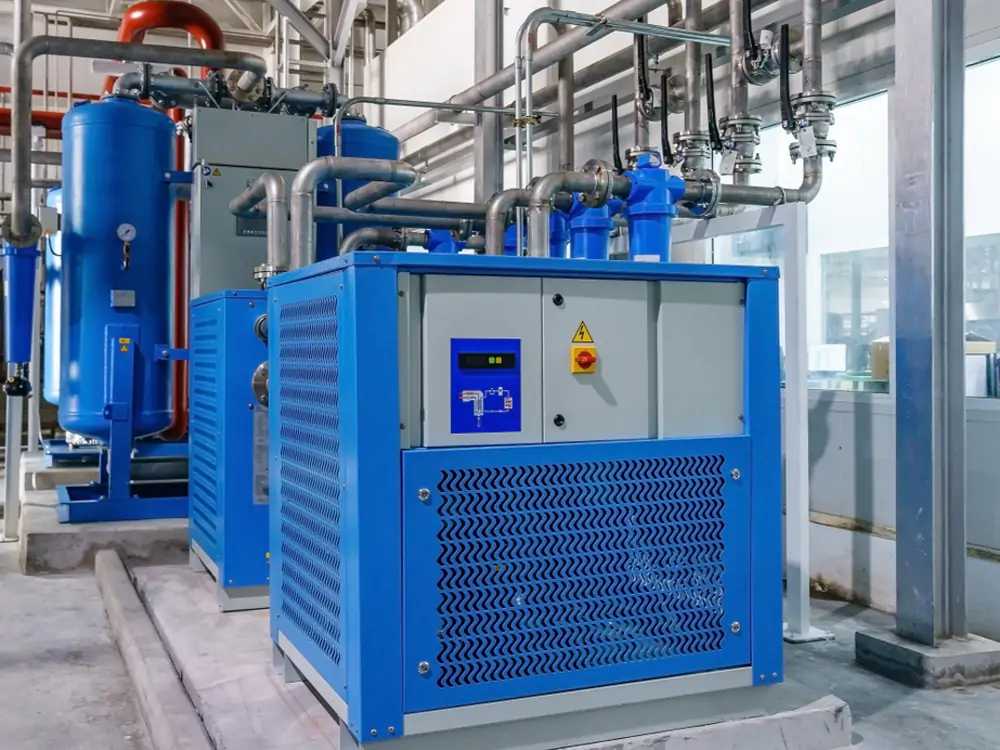
A refrigerated air dryer for compressor is a standard device to remove moisture and humidity from compressed air. Refrigerated compressed air dryers are typically used when a centralized dryer system’s cost or location constraints cannot be met. They can also be used where dryers are smaller or frequent system outages are expected.
It is a specially designed solution for removing moisture from the air to power pneumatic systems. The condensation of moisture in compressed air is similar to how a domestic refrigerator works. The condensing unit cools the air. Vapors in the air are condensed and collected in separate tanks or released directly into the atmosphere.
Composition
- Compressor: The compressor compresses the air to the required working pressure. A rotating or reciprocating piston usually accomplishes this.
- Cooler: The cooler is one of the key components in the dryer. After the compressed air enters the cooler, it flows through the pipes and surfaces of the cooler, reducing its temperature.
- Condenser: The condenser is another important part of the refrigeration dryer. The compressed air cooled in the cooler enters the condenser. The temperature inside the condenser is below the dew point temperature, causing the moisture and humidity to condense into liquid water, which is removed through the drain system.
- Coolant: Refrigerated dryers use a special coolant. Usually, a refrigerant, such as ammonia, freon, etc. The coolant circulates through the system, transferring heat between the cooler and condenser to maintain the proper temperature differential.
- Control System: Dryers are usually equipped with a control system to monitor and control the operation of various components. It can monitor parameters such as pressure, temperature, and humidity. Adjust operating parameters as needed to ensure an efficient drying process.
Applications
- Industrial Manufacturing: refrigerated compressor air dryer is widely used in various industrial manufacturing fields. Such as automobile manufacturing, electronics manufacturing, food and beverage processing, textiles, pharmaceuticals, etc. In these areas, dry compressed air is critical for equipment operation, product quality, and process efficiency in production processes.
- Refrigeration And Air Conditioning: Refrigerator air compressor dryers remove moisture from compressed air in refrigeration and air conditioning systems. This avoids condensation and corrosion on coolers and other critical components. Dry compressed air can improve system performance and reliability and extend the life of the equipment.
- Medical And Laboratory: In medical and laboratory environments, dry compressed air is essential to ensure the stability of the equipment. Refrigerated air compressor dryers can be used to remove moisture from compressed air. Therefore, the normal operation of sensitive instruments and experimental equipment can be protected.
- Pneumatic Tools And Control Systems: Dry compressed air prevents rusting, clogging, and failure of cylinders and valves. Refrigerant air compressor dryers can provide dry compressed air. So it can ensure pneumatic equipment’s proper functioning and long-lasting performance.
Pros
- Refrigerated dryers do not need to be re-activated and require minimal maintenance.
- Refrigerated dryers are more energy efficient compared to other types of dryers.
- The cost of running a refrigerated dryer is much lower than other types of dryers.
- They constantly remove moisture from the air and reduce system downtime.
- They are smaller than other dryer types and can be placed in tight locations.
Cons
- It has a high initial cost when compared to other types of dryers.
- Refrigerated dryers take up more space and need sufficient ventilation.
- They also require dedicated energy to run, which can increase operational costs.
Desiccant Compressed Air Dryer
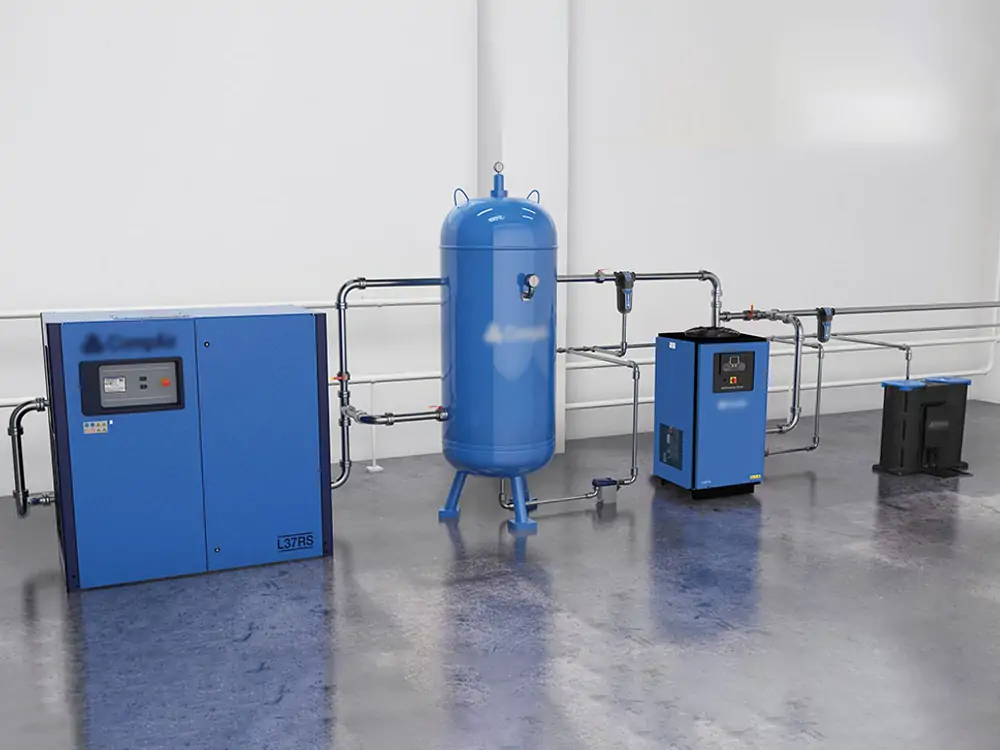
A desiccant compressed air dryer is integral to the air compression system. The dryer helps remove moisture, dirt, and oil during the air compression process and before storage. Desiccant compressed air dryers absorb water vapor to ensure the air delivered is dry and contaminant-free.
The dryer passes the air through a filter containing a silica gel or other desiccant material. This filter absorbs moisture from the air. The resulting air is drained and heated so that the moisture is released and does not return to the air stream.
Composition
- Compressor: The compressor handles compressing the air to the required working pressure. A rotating or reciprocating piston usually accomplishes this. The compressor is the core component of the entire compressed air system.
- Compressed Air Filter: Before the air enters the dryer, it passes through a compressed filter for preconditioning. Filters remove solid particles, oil, and other impurities from the air. This protects the subsequent drying process.
- Drying Tower: The drying tower is the core component of the adsorption dryer. It usually consists of two towers. They are working towers and regeneration towers. The working tower absorbs moisture and humidity from the air over some time. The regeneration tower is used to regenerate the working tower.
- Desiccant: Desiccant dryers use a desiccant to absorb moisture and humidity from the air. Common desiccants include silica gel, molecular sieves, and activated carbon. The working tower achieves the drying effect by absorbing the moisture onto the desiccant. The regeneration tower removes the adsorbed moisture using heating or decompression.
- Control System: The dryer is usually equipped with a control system. It is used to monitor and control the operation of various components. It can monitor parameters such as pressure, temperature, and humidity. Adjust operating parameters as needed to ensure an efficient drying process. The control system can also control the switching between the working tower and the regeneration tower to achieve a continuous drying process.
- Drainage System: During the drying process, after absorbing and removing moisture and humidity, they need to be discharged through the drainage system. Drainage systems may include automatic drain valves, pipes, and collectors. These can efficiently treat and discharge the liquid water produced.
Applications
- Automotive Painting And Coating: air compressor desiccant dryers are widely used to remove moisture and humidity from compressed air. Dry compressed air ensures the quality of the coating. It prevents air bubbles, unevenness of the painted surface and reduces the viscosity of the paint.
- Food And Beverage Processing: Dry compressed air is critical to product safety and quality. Compressed air desiccant dryers remove moisture from the air. It prevents microbial growth and oxidation reactions in food and beverages, thereby extending the shelf life of products.
- Medical And Pharmaceutical: The demand for clean and dry compressed air is very high in the medical and pharmaceutical sectors. Air compressor desiccant dryers can remove moisture and humidity from compressed air. Aseptic conditions and product purity for medical devices and pharmaceutical processes can thus be ensured.
- Electronics And Semiconductor Manufacturing: Minutes of moisture and humidity can seriously affect product quality and device performance. Desiccant air compressor dryers can provide dry compressed air. In this way, corrosion of electronic components, short circuits of lines, and failure of products can be avoided.
Pros
- Desiccant compressed air dryers can provide high air purity, essential for specific applications.
- They have low energy consumption and low noise levels.
Cons
- They have a high initial cost.
- They need periodic maintenance, as the desiccant material must be replaced or regenerated regularly.
- The dryers can generate excess heat in the air supply.
Membrane Compressed Air Dryer
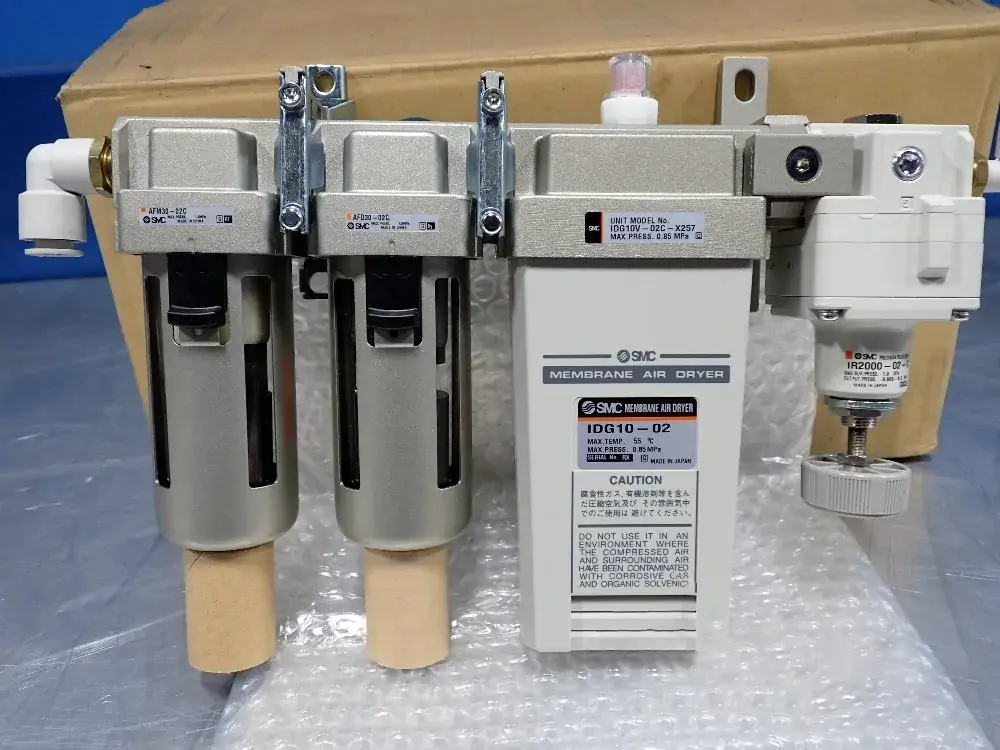
A membrane compressed air dryer is an efficient yet relatively low-cost way of ensuring the cleanliness of compressed air. It benefits moisture-sensitive processes, such as electronics, painting, food production, and welding. The mechanism works by separating moisture from the air in an air compressor and exhausting it through a dew point. This process helps to reduce the amount of water vapor in the air and allows the user to have dry air.
Composition
- Compressor: The compressor is the core component of the compressed air system. It handles compressing the air to the required working pressure. Compressors can be of different types, such as rotary, reciprocating, or centrifugal.
- Compressed Air Filter: Before the air enters the dryer, it passes through a compressed filter for preconditioning. The filter can remove solid particles, oil, and other impurities in the air to protect the subsequent drying process.
- Membrane Module: The membrane module is the key component of a Membrane air compressor dryer. It usually consists of a series of semipermeable membranes. These membranes have a special pore structure that selectively separates moisture and humidity from the air. When compressed air passes through the membrane module, water and moisture will pass through the membrane pores. The dry air passes through the membrane module.
- Membrane Airflow Control System: The membrane dryer has an airflow control system. It monitors and controls the gas flow during the drying process. It ensures proper gas velocity and pressure differential for the best drying results.
- Drainage System: During the membrane drying, the water and humidity separated by the membrane module must be discharged through the drainage system. Drainage systems typically include automatic drain valves, pipes, and collectors. They can efficiently treat and discharge the liquid water produced.
- Control System: Dryers are usually equipped with a control system to monitor and control the operation of various components. It monitors pressure, temperature, and humidity and adjusts operating parameters. This ensures the effectiveness and stability of the drying process.
Applications
- Electronics And Semiconductor Manufacturing: This process demands clean and dry compressed air. A membrane air dryer for compressor uses special membrane components to separate moisture and humidity from compressed air. Dry air ensures product quality and equipment reliability.
- Laboratory And Scientific Research: This field requires a precise and stable experimental environment. A membrane air dryer for compressor can provide dry compressed air. It can prepare instruments and equipment, laboratory reagents, and reaction substances. This ensures the accuracy and reproducibility of experimental results.
- Medical Facilities: Dry compressed air is critical to the proper functioning of medical equipment and the safety of patients. Membrane compressor air dryers can be used to remove moisture from compressed air. This prevents corrosion, bacterial growth, and gas contamination of the equipment. Cleanliness and hygiene of the medical environment can thus be ensured.
- Food And Beverage Processing: Food and beverage processing highly demand dry compressed air. Membrane compressor air dryers remove moisture from the air and prevent microbial growth, oxidation reactions, and spoilage in food and beverages. Thereby ensuring product quality and safety.
Pros
- It is relatively inexpensive to use.
- It is highly customizable depending on the end-users needs.
- It is incredibly efficient in removing moisture from the air.
- A Membrane compressor air dryer can be used in humid environments and requires no maintenance.
Cons
- It can be noisy.
- Some membranes require pre-treatment before usage.
- It is not as efficient as other air dryers.
- It is more prone to blockages.
Deliquescent Compressed Air Dryer
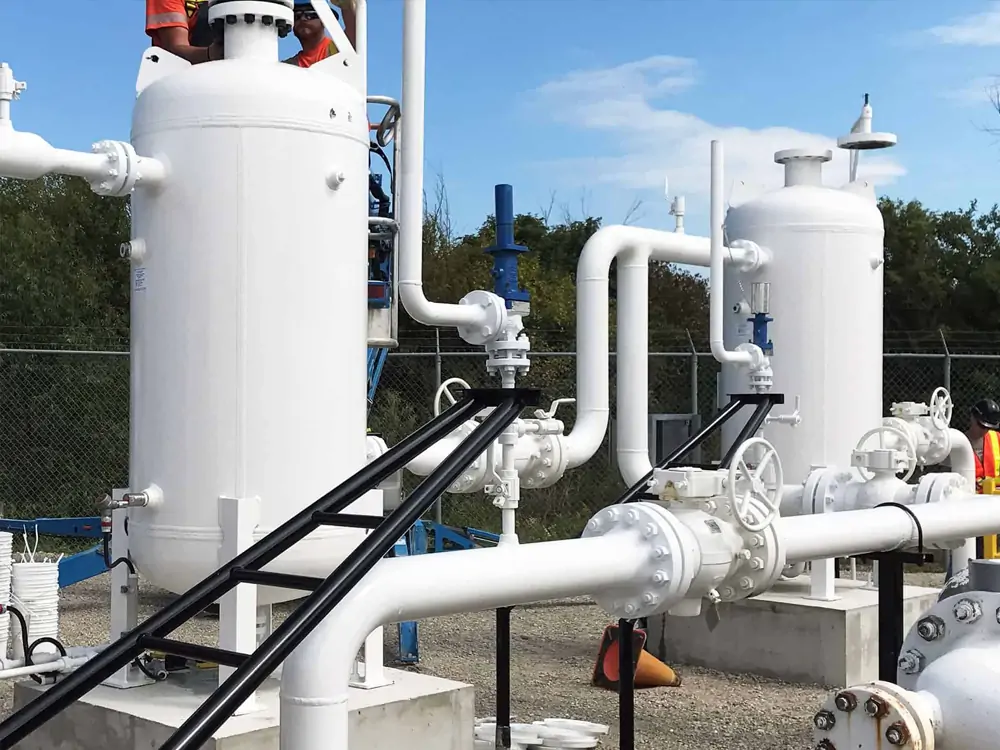
Deliquescent compressed air dryers are essential for any business that must maintain proper drying performance for air systems. Essentially, air compressor dryers remove the humidity from the air, allowing it to be used safely. They ensure that the air within the system remains free from condensation and water buildup. This is necessary to maintain optimal operating conditions within the system.
Deliquescent compressed air dryers offer great control over the drying process. Because they can be adjusted to treat specific humidity levels. They are highly reliable and offer high-performance drying. Most deliquescent compressed air dryers use a specially formulated deserial. It absorbs moisture from the process air.
Composition
- Compressor: The compressor is the core component of the compressed air system. It is used to compress air to the required working pressure. Compressors are available in different types of designs and operating principles. Such as rotary, reciprocating, or centrifugal.
- Compressed Air Filter: Before the compressed air enters the dryer, it is pretreated by passing through the compressed air filter. The function of the filter is to remove solid particles, oil, and other impurities in the air to protect the subsequent drying process.
- Solvent Storage Tank: A solvent storage tank is a key component in a dissolution dryer. Tanks are usually filled with a special solvent. Examples include calcium chloride or sodium sulfate. These solvents are hygroscopic and absorb moisture and humidity from the air.
- Drying Towers: Dissolving dryers usually have two drying towers. They are the working towers and regeneration towers, respectively. The solvent in the working tower absorbs the moisture in the air to dry the compressed air. The regeneration tower regenerates the hygroscopic solvent by heating or passing dry compressed air.
- Control System: The dryer is equipped with a control system. It is used to monitor and control the operation of various components. It monitors pressure, temperature, and humidity and adjusts operating parameters. This ensures the effectiveness and stability of the drying process.
- Drainage: During the drying process, water and humidity absorbed by the dissolver form a liquid. It needs to be removed through the drainage system. Drainage systems typically include components such as drain valves, drain pipes, and drain collectors. This allows efficient disposal and drainage of the resulting liquid.
Applications
- Mining And Construction: Deliquescent air compressor dryers are commonly used in fieldwork and field environments. Especially in high-humidity areas. They can help remove moisture from compressed air, preventing corrosion and damage to equipment and tools from water vapor.
- Environmental Monitoring And Meteorology: Removing moisture from compressed air ensures the accuracy of measuring equipment. They can avoid the influence of humidity on meteorological observation and environmental monitoring data and provide reliable results.
- Spray And Powder Coating: Remove moisture from compressed air to ensure coating quality and uniformity. Dry air can reduce problems such as air bubbles, water droplets, and uneven color during painting. This improvesthe adhesion and appearance of the coating.
- Food And Beverage Packaging: remove moisture from compressed air to prevent moisture and deformation of packaging materials. Dry air ensures the airtightness and shelf life of food and beverage packaging.
Pros
- They require little maintenance. Because they can be installed and left unattended for long periods.
- Deliquescent compressed air dryers can be incorporated into existing air conditioning systems to appropriately dry the entire air system.
- They improve energy efficiency. Because less energy is used to heat and cool the air and pump it through the system.
- They provide a high dew point in the compressed air.
Cons
- They can be noisy when running.
- They can be pretty expensive to install and maintain, depending on the size and complexity of the system.
- The desiccant material used in deliquescent compressed air dryers is not always reusable. It must be replaced regularly.
Heatless Compressed Air Dryer
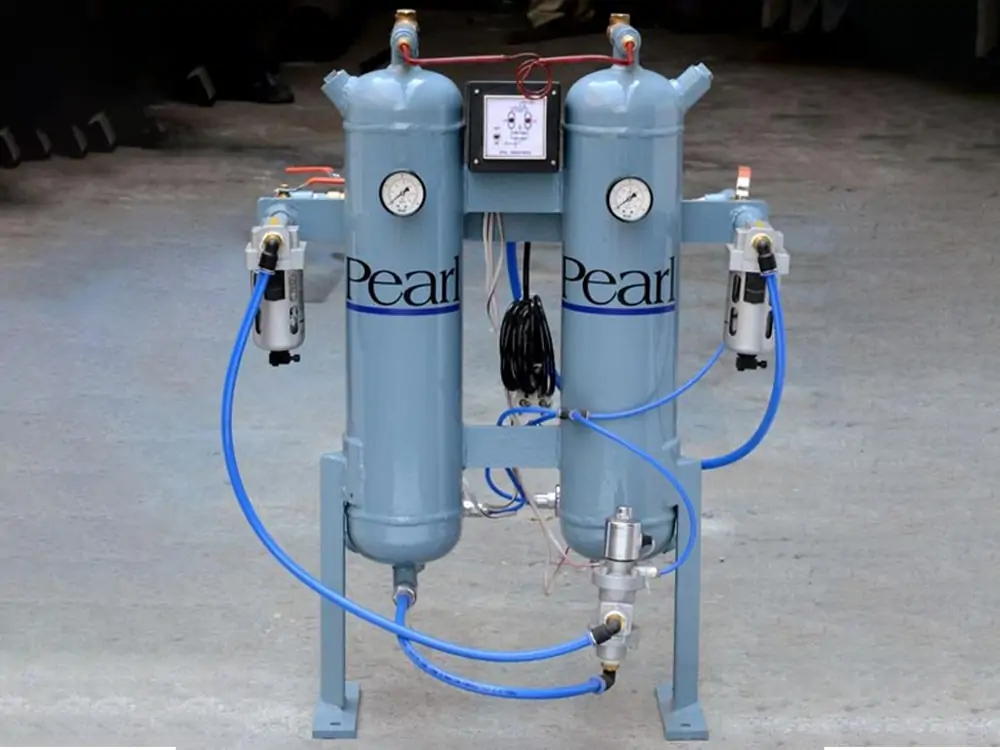
Heatless compressed air dryers provide high-efficiency, reliable air dryers for various industrial applications. As the name suggests, heatless air compressor dryers use no heat in drying. So it has a more efficient air drying system than conventional systems. Heatless compressor air dryers are used in various industries. Including paint manufacturing, pharmaceutical production, and food packaging.
Composition
- Compressor: The compressor is the core component of the compressed air system. It is used to compress air to the required working pressure. Compressors are available in different types of designs and operating principles. Such as rotary, reciprocating, or centrifugal.
- Compressed Air Filter: Before the compressed air enters the dryer, it is pretreated by passing through the compressed air filter. The function of the filter is to remove solid particles, oil, and other impurities in the air. This protects the subsequent drying process.
- Drying Tower: A heatless dryer usually consists of two drying towers. They are the working towers and regeneration towers,s respectively. These columns are usually packed with a special adsorbent. Examples include molecular sieves or activated carbon. The working tower achieves the drying effect by absorbing moisture and humidity in the air. The regeneration tower is used to regenerate the saturated adsorbent.
- Switching Valve: The dryer is equipped with a switching valve, which is used to control the airflow direction and switch between towers. The switching valve will periodically change the working state of the drying tower, making one of the towers work while regenerating the other.
- Control System: The dryer is equipped with a control system for monitoring and controlling the operation of each component. It monitors pressure, temperature, and humidity and adjusts operating parameters. This ensures the effectiveness and stability of the drying process.
- Drainage: During the drying process, the sorbent absorbs moisture and humidity from the air, forming a liquid. Drainage systems include components such as drain valves, drain pipes, and drain collectors. These components are used to handle and drain the resulting fluids efficiently.
Applications
- Manufacturing: heatless compressor air dryers can remove moisture and humidity from compressed air to ensure the dry air required in production. Pneumatic tools, spraying equipment, and control systems in the manufacturing industry all require dry compressed air. This maintains good performance and reliability.
- Food And Beverage Processing: The food and beverage processing industry has a high demand for dry air. Heatless air compressor dryers remove moisture from compressed air to prevent microbial growth and oxidation reactions in food and beverages. Dry air helps maintain the quality and shelf life of food and beverages.
- Electronics And Semiconductor Manufacturing: Minutes of moisture and humidity can seriously affect product quality and device performance. Heatless air compressor dryers can provide dry compressed air. Corrosion of electronic components, short circuits of lines, and failure of products can thus be avoided.
- Auto Repair And Painting: Dry air ensures the quality of your painting job. This prevents air bubbles, unevenness of the painted surface and reduces the viscosity of the paint.
Pros
- They provide a much higher moisture removal efficiency. Because they draw in air from the atmosphere.
- They can remove oil, dust, and other impurities, producing higher air quality.
- They require less maintenance and have a longer life span.
Cons
- Their initial cost is relatively high.
- They may require regular, periodic recharging of the desiccant to ensure optimal performance.
- If not used correctly, they can be prone to clogging or malfunctioning.
How to Select A Perfect Compressed Air Dryer Type
- Consider the dew point: A compressed air dryer should maintain dew points between +3° to -40°C.
- Consider the flow rate: select an air dryer with the capacity to match the flow rate of your air compressor.
- Understand the type of air dryer you need: understand the type of air dryer you need— refrigerated, desiccant, membrane, the heat of compression, or deliquescent.
- Consider the cost: Consider upfront and long-term costs associated with acquiring and running the air dryer.
- Consider the maintenance needs: Different types of dryers require different maintenance levels.
- Consider the dryer’s location: Consider the environment where you will install the dryer and select an appropriate location.
- Consider installation: Select a dryer that can be easily installed and maintained.
- Consider the after-sales service: Check whether the manufacturer offers any after-sales service or technical support.
Conclusion
In this article, we have introduced several common compressed air dryer types. Each type has its unique working principles and applicable scenarios. Choosing the right compressed air dryer type depends on the application scenario and the requirement for dryness. Before choosing, factors such as air quality, working environment conditions, energy consumption, and maintenance costs need to be considered. Proper selection and use of compressed air dryers can ensure the reliability and efficiency of your compressed air system.
Air compressor dryers play a key role in many industrial and commercial fields. They help maintain the quality and stability of compressed air. By understanding the different types of dryers and their characteristics, we can better understand how to choose the right drying solution for our needs and ensure that compressed air is drying as expected.
